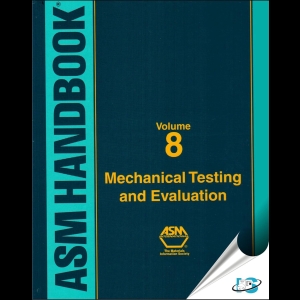ASM Handbook, Volume 8: Mechanical Testing and Evaluation describes the mechanical behavior of metals, composites, ceramics, and polymers and how it translates to measurable properties that can be used in product design and manufacturing. It explains how to acquire and analyze property data from a wide range of tests, including tension, compression, bend, and shear tests, micro and macro-scale hardness tests, and tests for friction and wear. It also describes creep and stress-relaxation testing, impact and fracture toughness testing, fatigue testing, and high strain rate testing. The volume addresses equipment, fixturing, and data evaluation, and presents strategies for testing gears, bearings, fasteners, pressure vessels and piping, welds, and adhesive-bonded joints.
Contents
INTRODUCTION TO MECHANICAL TESTING AND EVALUATION
Introduction to the Mechanical Behavior of Metals
Introduction to the Mechanical Behavior of Nonmetallic Materials
Mechanical Testing of Polymers and Ceramics
Overview of Mechanical Properties and Testing for Design
Mechanical Testing for Metalworking Processes
Testing Machines and Strain Sensors
Accreditation of Mechanical Testing Laboratories
TENSION, COMPRESSION, BEND, AND SHEAR TESTING
Mechanical Behavior Under Tensile and Compressive Loads
Stress-Strain Behavior in Bending
Fundamental Aspects of Torsional Loading
Uniaxial Tension Testing
Uniaxial Compression Testing
Hot Tension and Compression Testing
Tension and Compression Testing at Low Temperatures
Bend Testing
Shear, Torsion, and Multiaxial Testing
HARDNESS TESTING
Introduction to Hardness Testing
Macroindentation Hardness Testing
Microindentation Hardness Testing
Instrumented Indentation Testing
Indentation Hardness Testing of Ceramics
Miscellaneous Hardness Tests
Selection and Industrial Applications of Hardness Tests
Gage Repeatability and Reproducibility in Hardness Testing
Hardness Conversions for Steels
FRICTION, WEAR, AND SURFACE TESTING
Introduction to Adhesion, Friction, and Wear Testing
Adhesion Testing
Testing Methods for Solid Friction
Scratch Testing
Abrasive Wear Testing
Solid Particle Erosive Wear Testing
Sliding Contact Damage Testing
CREEP AND STRESS-RELAXATION TESTING
Introduction to Creep and Stress-Relaxation Testing
Creep Deformation of Metals, Polymers, Ceramics, and Composites
Creep and Creep-Rupture Testing
Assessment and Use of Creep-Rupture Properties
Stress Relaxation Testing
Influence of Multiaxial Stresses on Creep and Creep Rupture of Tubular Components
Superplastic Deformation at Elevated Temperatures
HIGH STRAIN RATE TESTING
Introduction to High Strain Rate Testing
High Strain Rate Tension and Compression Tests
High Strain Rate Shear Testing
Classic Split-Hopkinson Pressure Bar Testing
Recovery Hopkinson Bar Techniques
Split-Hopkinson Pressure Bar Testing of Soft Materials
Split-Hopkinson Pressure Bar Testing of Ceramics
Torsional Kolsky Bar Testing
Triaxial Hopkinson Techniques
Dynamic Indentation Testing
Shock Wave Testing of Ductile Materials
Low-Velocity Impact Testing
IMPACT TOUGHNESS TESTING AND FRACTURE MECHANICS
Fracture Toughness and Fracture Mechanics
Fracture Toughness Testing
Creep Crack Growth Testing
Impact Toughness Testing
Evaluation of Environmentally Assisted Crack Growth
Fracture Resistance Testing of Plastics
Fracture Toughness of Ceramics and Ceramic Matrix Composites
Fracture Resistance Testing of Brittle Solids
FATIGUE TESTING
Fatigue and Fracture Mechanics
Fatigue, Creep Fatigue, and Thermomechanical Fatigue Life Testing
Ultrasonic Fatigue Testing
Fretting Fatigue Testing
Fatigue Crack Growth Testing
Fatigue Testing and Behavior of Plastics
Fatigue Testing of Brittle Solids
Multiaxial Fatigue Testing
COMPONENT TESTING
Introduction to Mechanical Testing of Components
Testing for Deformation Modeling
Mechanical Testing of Threaded Fasteners and Bolted Joints
Testing of Adhesive Joints
Mechanical Testing of Welded Joints
Testing of Bearings
Mechanical Testing of Gears
Testing of Pressure Vessels, Piping, and Tubing
Residual Stress Measurements
Mechanical Testing of Fiber-Reinforced Composites
STATISTICS AND DATA ANALYSIS
Introduction to Statistics and Data Analysis
Statistical Distributions
Planning of Comparative Experiments
Analysis of Designed Experiments
Design Allowables for Static Metallic Material Properties
Fatigue Crack Growth Data Analysis
Analysis of Creep and Creep-Rupture Data
Fatigue Data Analysis
REFERENCE INFORMATION
Property Comparison Tables: Hardness and Tensile Properties
Glossary of Terms: Mechanical Testing and Evaluation
Supplemental Articles
The Role of Elasticity in Hardness Testing

